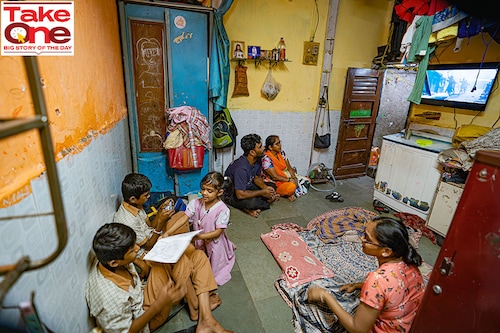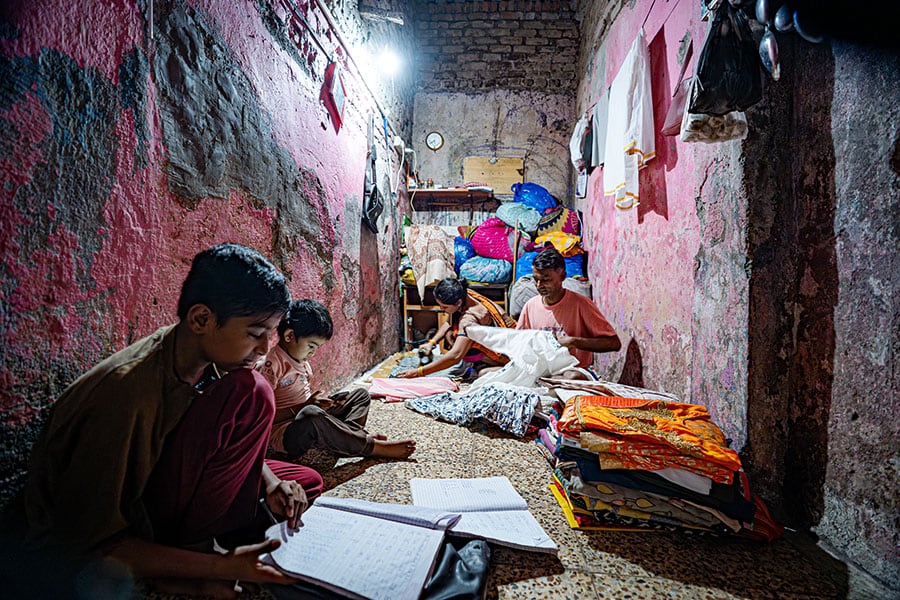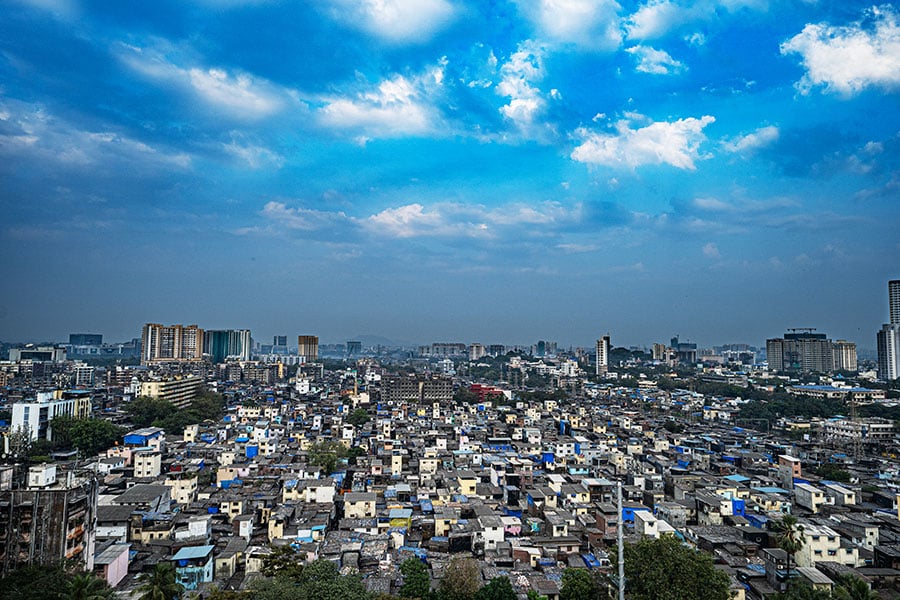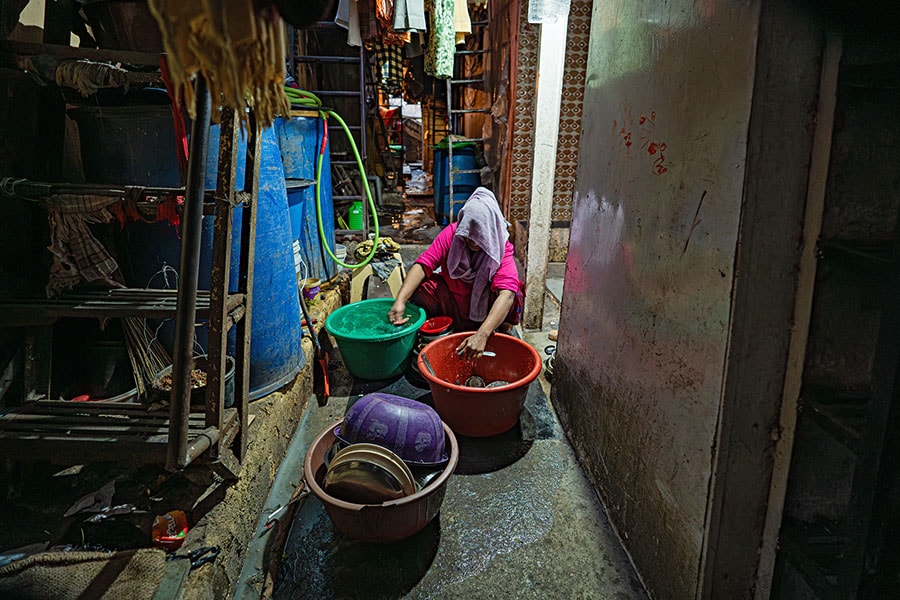Adani Group plans to commence work on Dharavi redevelopment this year, but uncer
Even as group plans education programmes and a survey, doubts about TDR and complexities around the eligibility of slum dwellers remain


The past few weeks have been distressing for 48-year-old Karuna Patil and other residents of Sanjay Gandhi Nagar and Samata Nagar Chawl in Mumbai’s Dharavi, located next to railway lines. Patil, who works as a babysitter in Mahim, has rushed back home from her job to save her house twice. The dwellers have been served with multiple notices by the divisional railway manager (DRM) of the Central Railway Mumbai division to evict the area, claiming that they have encroached on railway land. The Railway Protection Force (RPF) and the Brihanmumbai Electric Supply and Transport Undertaking (BEST) also visited asking them to vacate the place and threatening to cut electricity and water lines.
Patil lives with her husband in a 100-sq-ft space, which they bought almost four decades ago. They"ve also managed to add a floor, which is occupied by her son, wife, and their child. “It was a scary situation for us because the officials asked us to leave without even offering an alternate house," says Patil. After social workers protested and the Slum Rehabilitation Authority (SRA) wrote to the railway manager, there was an interim stay on the issued notice.“The said land on which the chawl exists is part of the Dharavi redevelopment project area (land adjoining the harbour line connected to the Central Line and Western Railway from Matunga to Mahim station). Hence, the redevelopment of slums under the lease deed is the responsibility of a Special Purpose Vehicle Company appointed by the DRP/SRA," said the letter sent to the central railway DRM from the SRA. “We are going to start a survey of the slum dwellers, and eligible hutments will get the benefits as per the Slum Act and rules," it added.
In the last 60 days, there have been a number of developments around the revamp of Asia"s largest slum spread across 600 acres. The latest one is the Maharashtra government"s notification on Transfer of Development Rights (TDR). In November last year, the state government issued a notification to bring in changes to the Development Control Rules (DCR), which have allowed the use of TDR without an indexation. This modification will give more value to the Adani group for the TDR generated from the Dharavi Redevelopment Project (DRP) and mandate all builders in Mumbai to buy the first 40 percent of their required TDR from DRP. Political parties allege that the Maharashtra government favoured the Adani Group by approving this. Additionally, they claim that the government fixed the price of TDR at 90 percent of the ready reckoner rate, which could lead to a monopoly for the Adani Group and increase real estate prices in Mumbai.
 A family of six lives together in a 100-square-foot house in Dharavi. Image: Mexy Xavier
A family of six lives together in a 100-square-foot house in Dharavi. Image: Mexy Xavier
The initial proposal for the TDR allocation was made in September 2022, but the gazette notification was issued in November 2023. According to experts, the impact on real estate prices in Mumbai is expected to be minimal as most ongoing projects are self-sufficient in their TDR needs or generate surplus TDR.
About 1/3rd of housing projects in Mumbai use TDR for their FSI needs. Although it will squeeze out the small builders because they are dependent on TDR, explains real estate expert Vishal Bhargava. “Small redevelopment projects in suburban projects are likely to be consumers of TDR. So they will have to go to Adani, and their price is not lucrative because it’s 90 percent of the ready reckoner rate, whereas the market price typically has been between 40 and 65 percent." The projects that opt for TDR will see their costs rise in a consumer market that is resistant to price hikes, which will lead to higher costs in several Mumbai housing projects, adds Bhargava.
The Dharavi project will rehabilitate approximately 12 lakh people from around the 55 lakh slum population in Mumbai. The timeline mandated in the tender for completion of the redevelopment is set at seven years. This will lead to a significantly high cash outflow for the construction of the rehabilitation units. With the avenues for monetisation of sales FSI in the period being limited, it could lead to a huge cash deficit for Adani. According to the group, mandatory sourcing of TDR will help in the generation of upfront cash for construction. Without the mandatory sourcing of TDR, a redevelopment project of such scale would not be possible, they say. If slum redevelopment as per the sale component development or TDR sale in the market was allowed, then the redevelopment project would take around 25 to 30 years.
 A glimpse of Dharavi from an under-construction building. Image: Mexy Xavier
A glimpse of Dharavi from an under-construction building. Image: Mexy Xavier
The eligibility issue is a constant in all SRA schemes, and this project is very unique because people are in lakhs of numbers, says SVR Srinivas, officer on special duty, Slum Rehabilitation Authority and CEO of the Dharavi Redevelopment Project. “Usually we only have to deal with 300–400 people, but this is a large-scale project. The ineligible don"t get anything, but Dharavi is a special project, so those who are eligible will get free houses, and those who aren"t eligible will be accommodated in a rental housing project. Houses will be given to them on rent, and they will also be eligible to purchase them, the price of which will be determined by the government."
Social worker and activist Sanjay Bhalerao is concerned about the transparency in terms of the determination of the eligibility criteria. “We have been demanding for a fresh survey to be conducted, and it should definitely not happen under Adani’s purview. We don"t trust them. They don"t think about the welfare of the people living here and are only concerned with making profits out of this project," says Bhalerao, a Dharavi resident who has been working with the development authority ever since the project was launched by the Maharashtra government in 2004.
Conversely, another dweller, Chandrasekhar Swami, feels the protestors have unreasonable demands. “For the last 25 years, we have been waiting for the redevelopment to happen this is a huge project. The central and state governments are finally taking it seriously. People are not even concerned about the square feet anymore. They just need a house with the basic necessities of life. Adani is capable of doing this or not who are we to decide that?" says Swami, who runs the Vishwatmak Samajik Seva Trust and lives in an 80-sq-ft house.
Srinivas of SRA assures that the master plan will be in consonance with the local needs. “In a few weeks, we are going to begin with a small pilot survey. If everything goes as planned, we will start the construction this year."
Another concern is the businesses operating in Dharavi. It houses more than 12,000 micro, small, and medium enterprises (MSMEs) engaged in businesses such as leather making, garment manufacturing, pottery, and plastic recycling. These industries export goods across the globe, with an estimated annual turnover of around $1 billion. All the commercial industry units in Dharavi will be getting GST reimbursement for five years from the state government, says Srinivas.
Around 45,000 houses run their businesses in-house, from small to large, says Shiv Sena (UBT) member of parliament Vinayak Raut. On a daily basis, they earn Rs 200 to Rs 20,000. “Adani is trying to focus more on how to make the maximum number of people fall under the ineligibility criteria. And currently, whoever is eligible gets a meager 351 square feet of space in a high-rise building. We are demanding they be given at least a 400-square-foot house, and the home industries should also be accommodated alongside," says Raut.
“All the Government Resolutions (GR) issued since September 2022 are in favour of Adani, and none of them mention anything about the welfare of people living there. We are not against Adani. We"re just concerned about the freebies provided to them by the state government," he adds.
 A woman washes dishes in the common area in Dharavi. Image: Mexy Xavier
A woman washes dishes in the common area in Dharavi. Image: Mexy Xavier
“This is primarily due to a lack of understanding of the needs of the slum dwellers themselves. Here is where the government could take on the role of a facilitator, not just by offering incentives to private developers for redevelopment but also by acting as a mediator between NGOs, think tanks, primary stakeholders (slum dwellers), and other infrastructure and service delivery agencies."
The goal is to protect the interests of the beneficiaries. Ultimately, the government must ensure that the slum dwellers are empowered to actively shape and lead the process of redevelopment, adds Madhavanunni.
An Adani Group spokesperson from DRPPL told Forbes India that the preparations for a survey are in advanced stages. After the information, education, and communication programme starts soon, the survey work will begin progressively. The Dharavi Redevelopment Project Pvt. Ltd. (DRPPL) has appointed survey agency Genesys International to conduct the survey. “Genesys will deploy its digital twin mapping technology for the survey. This will be one of the most complex mapping projects, where modern technology will be able to map the most challenging areas. The survey will be the first step towards social and financial inclusion in Dharavi."
It"s a complex project, coupled with resistance and opposition. After all, Dharavi is a cash cow for a lot of political stakeholders, says real estate expert Bhargava. “Every month, slumlords and politicians are making huge amounts of money. They will now have to exit from this project and relinquish control of Dharavi, so there will be opposition. At this point, if anyone is capable of pulling this off, it is Adani. The government is also strongly backing it. So for the sake of Mumbai, I hope he succeeds."
First Published: Jan 09, 2024, 15:54
Subscribe Now